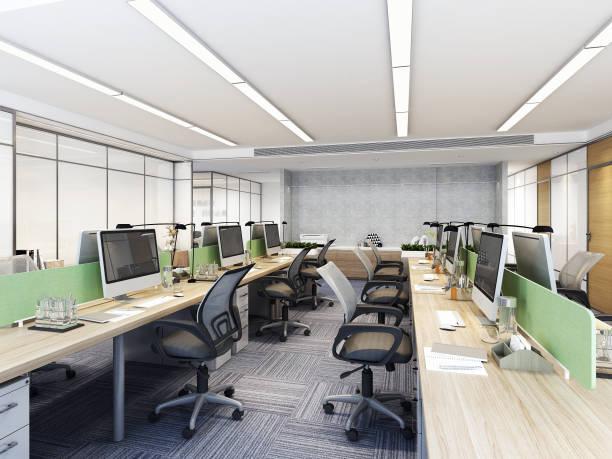Introduction to Cubicle Office
The cubicle office – a term that has become synonymous with the corporate landscape over the past few decades. From its inception as a solution to office layout challenges to its often-criticized reputation for fostering isolation, the cubicle has undergone a fascinating evolution. In this article, we explore the history, design, advantages, disadvantages, and the future of the cubicle office, shedding light on its impact on productivity, employee well-being, and the ever-changing dynamics of the modern workplace.
Origins and Evolution
The concept of the cubicle was popularized in the 1960s as a response to the need for more efficient office space utilization. Inspired by the idea of demountable walls, designer Robert Propst conceptualized the cubicle as a flexible and adaptable workspace. Initially intended to break free from the constraints of traditional office layouts, cubicles aimed to provide employees with their own defined workspace while maintaining an open and collaborative environment.
Advantages of Cubicle Offices
a. Space Efficiency: One of the primary advantages of cubicle offices is their space efficiency. By utilizing vertical space and standardized components, companies can accommodate more employees within a given floor area compared to traditional offices with separate rooms.
b. Cost-Effectiveness: Cubicle offices are often more cost-effective than constructing individual offices or open-plan layouts. The modular nature of cubicles allows for easier installation, reconfiguration, and lower construction costs.
c. Customization: Cubicles can be customized to suit the needs and preferences of individual employees. This level of personalization can contribute to a sense of ownership and comfort in the workspace.
Disadvantages and Criticisms
a. Isolation and Lack of Privacy: Perhaps the most significant criticism of cubicle offices is the perceived isolation they can create. While designed to provide a degree of privacy, cubicles can sometimes foster a sense of detachment and hinder spontaneous collaboration.
b. Monotonous Design: The uniformity of cubicle designs can contribute to a monotonous and uninspiring work environment. The sea of identical partitions may lead to a lack of creativity and personalization within the workspace.
c. Noise Concerns: Despite attempts to provide privacy, modern cubicles may not offer sufficient sound insulation. This can result in an environment where noise becomes a significant distraction, impacting concentration and overall productivity.
The Impact on Productivity
a. Task-Oriented Focus: Cubicles can provide a dedicated space for employees to focus on individual tasks without the distractions of an open-plan office. This focused environment can contribute to increased productivity for certain job roles.
b. Communication Challenges: On the flip side, the cubicle’s focus on individual workspaces can create barriers to communication. Limited face-to-face interaction may hinder spontaneous collaboration and idea-sharing among team members.
Adapting Cubicles for Modern Work Trends
a. Flexibility and Collaboration: Recognizing the need for flexibility and collaboration, modern cubicle designs have evolved. Many companies are incorporating collaborative spaces within cubicle layouts, promoting a balance between focused work and team interaction.
b. Ergonomics and Employee Well-being: Modern cubicles often prioritize ergonomic design, providing adjustable desks and chairs to enhance employee comfort. Additionally, incorporating elements of biophilic design, such as natural light and plants, can contribute to improved well-being.
c. Hybrid Work Environments: As the trend towards hybrid work models gains momentum, cubicle offices are adapting to accommodate both in-office and remote work. The flexibility of cubicles allows for a seamless transition between individual and collaborative work, supporting the diverse needs of a hybrid workforce.
The Future of Cubicle Offices
a. Integration of Technology: The future of cubicle offices lies in the integration of technology to enhance collaboration and productivity. Smart cubicles with integrated communication tools, personalized lighting, and environmental controls are becoming more common, providing employees with a technologically advanced and efficient workspace.
b. Well-being and Flexibility: The focus on employee well-being will continue to drive changes in cubicle design. Incorporating features that support physical and mental health, as well as providing flexibility in workspace configuration, will be essential in shaping the future of cubicle offices.
c. Design Innovation: Designers are exploring innovative ways to break away from the traditional cubicle aesthetic. Varied shapes, materials, and configurations are being introduced to create visually appealing and dynamic workspaces that challenge the stereotype of the dull cubicle office.
Conclusion
The cubicle office, once hailed as a revolutionary solution to office layout challenges, has faced its fair share of criticisms over the years. While its impact on productivity and employee well-being has been a subject of debate, the cubicle has evolved to meet the changing needs of the modern workplace. By embracing flexibility, technology, and a focus on employee comfort, the cubicle office continues to be a relevant and adaptable solution in the ever-evolving landscape of office design. As businesses navigate the post-pandemic era and embrace new work models, the cubicle office may find itself at the forefront of creating a balanced and efficient workspace for the future.

